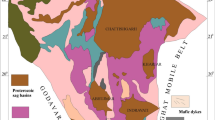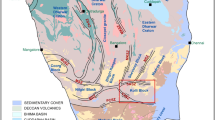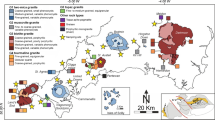Abstract
The chromite deposits in the Archean Nuggihalli schist belt are part of a layered ultramafic–mafic sequence within the Western Dharwar Craton of the Indian shield. The 3.1-Ga ultramafic–mafic units occur as sill-like intrusions within the volcano-sedimentary sequences of the Nuggihalli greenstone belt that are surrounded by the tonalite–trondhjemite–granodiorite (TTG) suite of rocks. The entire succession is exposed in the Tagdur mining district. The succession has been divided into the lower and the upper ultramafic units, separated by a middle gabbro unit. The ultramafic units comprise of deformed massive chromitite bodies that are hosted within chromite-bearing serpentinites. The chromitite bodies occur in the form of pods and elongated lenses (~60–500 m by ~15 m). Detailed electron microprobe studies reveal intense compositional variability of the chromite grains in silicate-rich chromitite (~50% modal chromite) and serpentinite (~2% modal chromite) throughout the entire ultramafic sequence. However, the primary composition of chromite is preserved in the massive chromitites (~60–75% modal chromite) from the Byrapur and the Bhaktarhalli mining district of the Nuggihalli schist belt. These are characterized by high Cr-ratios (Cr/(Cr + Al) = 0.78–0.86) and moderate Mg-ratios (Mg/(Mg + Fe2+) = 0.38–0.58). The compositional variability occurs due to sub-solidus re-equilibration in the accessory chromite in the serpentinite (Mg-ratio = 0.01–0.38; Cr-ratio = 0.02–0.99) and in silicate-rich chromitite (Mg-ratio = 0.06–0.48; Cr-ratio = 0.60–0.99). In the massive chromitites, the sub-solidus re-equilibration for chromite is less or absent. However, the re-equilibration is prominent in the co-existing interstitial and included olivine (Fo96–98) and pyroxene grains (Mg-numbers = 97–99). Compositional variability on the scale of a single chromite grain occurs in the form of zoning, and it is common in the accessory chromite grains in serpentinite and in the altered grains in chromitite. In the zoned grains, the composition of the core is modified and the rim is ferritchromit. In general, ferritchromit occurs as irregular patches along the grain boundaries and fractures of the zoned grains. In this case, ferritchromit formation is not very extensive. This indicates a secondary low temperature hydrothermal origin of ferritchromit during serpentinization. In some occurrences, the ferritchromit rim is very well developed, and only a small relict core appears to remain in the chromite grain. However, complete alteration of the chromite grains to ferritchromit without any remnant core is also present. The regular, well-developed and continuous occurrence of ferritchromit rims around the chromite grain boundaries, the complete alteration of the chromite grains and the modification of the core composition indicate the alteration in the Nuggihalli schist belt to be intense, pervasive and affected by later low-grade metamorphism. The primary composition of chromite has been used to compute the nature of the parental melt. The parental melt calculations indicate derivation from a high-Mg komatiitic basalt that is similar to the composition of the komatiitic rocks reported from the greenstone sequences of the Western Dharwar Craton. Tectonic discrimination diagrams using the primary composition of chromites indicate a supra-subduction zone setting (SSZ) for the Archean chromitites of Nuggihalli and derivation from a boninitic magma. The composition of the komatiitic basalts resembles those of boninites that occur in subduction zones and back-arc rift settings. Formation of the massive chromitites in Nuggihalli may be due to magma mixing process involving hydrous high-Mg magmas or may be related to intrusions of chromite crystal laden magma; however, there is little scope to test these models because the host rocks are highly altered, serpentinized and deformed. The present configurations of the chromitite bodies are related to the multistage deformation processes that are common in Archean greenstone belts.










Similar content being viewed by others
References
Abzalov MZ (1998) Chrome spinels in gabbro-wehrlite intrusions of the Pechenga area, Kola Peninsula, Russia: emphasis on alteration features. Lithos 43:109–134
Allègre CJ (1982) Genesis of Archean komatiites in a wet ultramafic subducted plate. In: Arndt NT, Nisbet EG (eds) Komatiites. George Allen and Unwin, London, pp 495–500
Bannister V, Roeder P, Poustovetov A (1998) Chromite in the Paricutin lava flows (1943–1952). J Volcanol Geotherm Res 87:151–171
Barnes SJ (1989) Are Bushveld U-type parent magmas boninites or contaminated Komatiites? Contrib Mineral Petrol 101:447–457
Barnes SJ (2000) Chromite in Komatiites. II. Modification during greenschist to mid-amphibolite facies metamorphism. J Petrol 41:387–409
Barnes SJ (2006) Komatiites: petrology, volcanology, metamorphism, and geochemistry. Econ Geol Special Publication 13, pp 13–49
Barnes SJ, Roeder PL (2001) The range of spinel compositions in terrestrial mafic and ultramafic rocks. J Petrol 42:2279–2302
Bidyananda M, Mitra S (2005) Chromitites from komatiitic affinity from the Archean Nuggihalli greenstone belt in South India. Mineral Petrol 84:169–187
Bidyananda M, Deomurari MP, Goswami JN (2003) 207Pb-206Pb ages of zircon from the Nuggihalli schist belt, Dharwar craton, southern India. Curr Sci 85:1482–1485
Bliss NW, MacLean WH (1975) The paragenesis of zoned chromite from central Manitoba. Geochim Cosmochim Acta 39:973–990
Burkhard DJM (1993) Accessory chromian spinels: their coexistence and alteration in serpentinites. Geochim Cosmochim Acta 57:1297–1306
Cameron EN (1977) Chromite in the central sector of the eastern Bushveld Complex, South Africa. Am Mineral 62:1082–1096
Cameron EN, Desborough GA (1969) Occurrence and characteristics of chromite deposits, eastern Bushveld Complex. Econ Geol Monogr 4:23–40
Crawford AJ, Falloon TJ, Green DH (1989) Classification, petrogenesis and tectonic setting of boninites. In: Crawford AJ (ed) Boninites. Unwin and Hyman, London, pp 2–44
Damodaran KT, Somasekar B (1976) Chrome chlorite (kotschubeite) from the Nuggihalli schist belt. Clays Clay Miner 24:31–35
De Wit MJ, Ashwal LD (1995) Greenstone belts: what are they? S Afr J Geol 98(4):505–520
Devaraju TC, Alapieti TT, Kaukonen RJ, Sudhakara TL (2007) Chemistry of Cr-spinels from ultramafic complexes of western Dharwar craton and its petrogenetic implications. J Geol Soc India 69:1161–1175
Devaraju TC, Viljoen RP, Sawkar RH, Sudhakara TL (2009) Mafic and ultramafic magmatism and associated mineralization in the Dharwar craton, southern India. J Geol Soc India 73:73–100
Dick HJB, Bullen T (1984) Chromian spinel as a petrogenetic indicator in abyssal and alpine-type peridotites and spatially associated lavas. Contrib Mineral Petrol 86:54–76
Droop GTR (1987) A general equation for estimating Fe3+ concentrations in ferromagnesian silicates and oxides from microprobe analysis, using stoichiometric criteria. Mineral Mag 51:431–435
Eales HV (2000) Implications of the chromium budget of the Western Limb of the Bushveld Complex. S Afr J Geol 103:141–150
Evans BW, Frost BR (1975) Chrome-spinel in progressive metamorphism—a preliminary analysis. Geochim Cosmochim Acta 39:959–972
Falloon TJ, Danyushevsky LV, Crawford AJ, Meffre S, Woodhead JD, Bloomer SH (2008) Boninites and adakites from the northern termination of the Tonga Trench: implications for adakite petrogenesis. J Petrol 49:697–715
Fan J, Kerrich R (1997) Geochemical characteristics of aluminum depleted and undepleted komatiites and HREE-enriched low-Ti tholeiites, western Abitibi greenstone belt: a heterogeneous mantle plume-convergent margin environment. Geochim Cosmochim Acta 61:4723–4744
Ford CE, Bigger GM, Humphries DJ, Wilson G, Dixon D, O’Hara MJ (1972) Role of water in the evolution of the lunar crust; an experimental study of sample 14310; an indication of lunar calc-alkaline volcanism. In: Proceedings of third lunar science conference, geochimica et cosmochimica acta supplement 1, pp 207–229
Gaetani GA, Grove TL, Bryan WB (1994) Experimental phase relations of basaltic andesite from hole 839B under hydrous and anhydrous conditions. In: Hawkins J, Parson L, Allan J (eds) Proceedings of the ocean drilling Program, scientific results 135, pp 557–563
Grove TL, Parman SW (2004) Thermal evolution of the earth as recorded by komatiites. Earth Planet Sci Lett 219:173–187
Grove TL, Parman SW, Dann JC (1999) Conditions of magma generation for Archean komatiites from the Barberton Mountainland, South Africa. In: Fei Y, Bertka CM, Mysen BO (eds) Mantle petrology; field observations and high-pressure experimentation; A tribute to Francis R (Joe) Boyd. Geochemical Society Publication 6, pp 155–167
Gupta S, Rai SS, Prakasam KS, Srinagesh D (2003) The nature of the crust in southern India: implications for Precambrian crustal evolution. Geophys Res Lett 30:1419. doi:10.1029/2002GL016770
Hamlyn PR, Keays RR (1979) Origin of chromite compositional variation in the Panton Sill, Western Australia. Contrib Mineral Petrol 69:75–82
Hicky RL, Frey FA (1982) Geochemical characteristics of boninite series volcanics: implications for their source. Geochim Cosmochim Acta 46:2099–2115
Irvine TN (1965) Chromian spinel as a petrogenetic indicator. Part I, Theory. Can J Earth Sci 2:648–671
Irvine TN (1967) Chromian spinel as a petrogenetic indicator. Part II, Petrographic applications. Can J Earth Sci 4:71–103
Irvine TN (1975) Crystallization sequences in the Muskox intrusion and other layered intrusions-II. Origin of chromitite layers and similar deposits of other magmatic ores. Geochim Cosmochim Acta 39:991–1020
Irvine TN (1977) Origin of chromitite layers in the Muskox intrusion and other layered intrusions: a new interpretation. Geology 5:273–277
Jackson ED (1969) Chemical variation in coexisting chromite and olivine in chromitite zones of the Stillwater complex. Econ Geol Monogr 4:41–71
Jafri SH, Khan N, Ahmed SM, Saxena R (1983) Geology and geochemistry of Nuggihalli schist belt, Dharwar craton, Karnataka, India. In: Naqvi SM, Rogers JJW (eds) Precambrian of South India. Memoir Geol Soc India No 4, pp 110–120
Jayananda M, Kano T, Peucat JJ, Channabasappa S (2008) 3.35 Ga komatiite volcanism in the western Dharwar craton, southern India: constraints from Nd isotopes and whole-rock geochemistry. Precambrian Res 162:160–179
Kamenetsky VS, Crawford AJ, Meffre S (2001) Factors controlling chemistry of magmatic spinel: an empirical study of associated olivine, Cr-spinel and melt inclusions from primitive rocks. J Petrol 42:655–671
Kerrich R, Wyman D, Fan J, Bleeker W (1998) Boninite series; low Ti-tholeiite associations from the 2.7 Ga Abitibi greenstone belt. Earth Planet Sci Lett 164:303–316
Leelananadam C, Burke K, Ashwal LD, Webb SJ (2006) Proterozoic mountain building in Peninsular India: an analysis based primarily on alkaline rock distribution. Geol Mag 143:1–18
Lenaz D, Andreozzi GB, Mitra S, Bidyananda M, Princivalle F (2004) Crystal chemical and 57Fe Mössbauer study of chromite from the Nuggihalli schist belt (India). Mineral Petrol 80:45–57
Lipin BR (1993) Pressure increases in the formation of chromite seams and the development of the ultramafic series in the Stillwater complex, Montana. J Petrol 34:955–976
Loferski PJ (1986) Petrology of metamorphosed chromite bearing rocks from the Red Lodge District, Montana. US Geol Surv Bull 1626-B:B1–B34
Loferski PJ, Lipin BR (1983) Exsolution in metamorphosed chromite from the Red Lodge district, Montana. Am Mineral 68:777–789
Manikyamba C, Naqvi SM, Rao DVS, Mohan MR, Khanna TC, Rao TG, Reddy GLN (2005) Boninites from the Neoarchaean Gadwal Greenstone belt, eastern Dharwar Craton, India: implications for Archaean subduction processes. Earth Planet Sci Lett 230:65–83
Marsh B (1996) Solidification fronts and magmatic evolution. Mineral Mag 60:5–40
Mathez EA, Mey JL (2005) Character of the UG2 chromitite and host rocks and petrogenesis of its pegmatoidal footwall, northeastern Bushveld complex. Econ Geol 100:1617–1630
Maurel C, Maurel P (1982) Etude expérimentale de la solubilité du chrome dans les bains silicatés basiques et sa distribution entre liquide et minéraux coexistants: conditions d’existence du spinelle chromifére. Bull Minéral 105:197–202
Mitra S, Bidyananda M (2001) Crystallochemical characteristics of chlorites from the greenstone belt of south India and their geothermometric significance. Clay Sci 11:479–501
Mitra S, Bidyananda M (2003) Evaluation of metallogenic potential of the Nuggihalli greenstone belt, South India. C R Geosci 335:185–192
Mitra S, Pal T, Maity PK, Moon HS (1992) Ferritchromit and its opto-chemical behavior. Mineral J 16:173–186
Mondal SK (2009) Chromite and PGE deposits of Mesoarchaean ultramafic-mafic suites within the greenstone belts of the Singhbhum craton, India: implications for mantle heterogeneity and tectonic setting. J Geol Soc India 73:36–51
Mondal SK, Mathez EA (2007) Origin of the UG2 chromitite layer, Bushveld complex. J Petrol 48:495–510
Mondal SK, Zhou M-F (2010) Enrichment of PGE through interaction of evolved boninitic magmas with early formed cumulates in a gabbro-breccia zone of the Mesoarchean Nuasahi massif (eastern India). Miner Depos 45:69–91
Mondal SK, Baidya TK, Rao KNG, Glascock MD (2001) PGE and Ag mineralization in a breccia zone of the Precambrian Nuasahi ultramafic-mafic complex, Orissa, India. Can Mineral 39:979–996
Mondal SK, Ripley EM, Li C, Ahmed AH, Arai S, Liipo J, Stowe C (2003) Oxygen isotopic compositions of Cr-spinels from Archean to Phanerozoic chromite deposits. Goldschmidt conference at Japan, Abstract with program, Abstract published in Geochim Cosmochim Acta, vol 18S, p A301
Mondal SK, Ripley EM, Li C, Frei R (2006) The genesis of Archean chromitites from the Nuasahi and Sukinda massifs in the Singhbhum craton, India. Precambrian Res 148:45–66
Mondal SK, Mukherjee R, Rosing MT, Frei R, Waight T (2008) Petrologic, geochemical and isotopic study of 3.1 Ga peridotite-chromitite suite from the western Dharwar craton (India): evidence for recycling of oceanic crust in the Mesoarchean. Eos Trans AGU 89(53), Fall Meet Suppl, Abstract V33C-2237
Murck BN, Campbell IH (1986) The effects of temperature, oxygen fugacity and composition on the behavior of chromium in basic and ultramafic melts. Geochim Cosmochim Acta 50:1871–1887
Murthy NGK (1987) Mafic dyke swarms of the Indian shield, Mafic swarms. Geol Assoc Canada special paper 34, pp 393–400
Naqvi SM (2005) Geology and evolution of the Indian plate (Hadean to Holocene—4 Ga to 4Ka). Capital, New Delhi, p 450
Nicholson DM, Mathez EA (1991) Petrogenesis of the Merensky Reef in the Rustenburg section of the Bushveld complex. Contrib Mineral Petrol 107:293–309
Nijagunappa R, Naganna C (1983) Nuggihalli schist belt in the Karnataka craton: an Archaean layered complex as interpreted from chromite distribution. Econ Geol 79:507–513
Papp JF (2008) Chromium-2006. In: USGS minerals yearbook 2006, pp 17.1–17.22
Parman SW, Grove TL, Dann JC (2001) The production of Barberton komatiites in an Archean subduction zone. Geophys Res Lett 28:2513–2516
Parman SW, Grove TL, Dann JC (2004) A subduction model for komatiites and cratonic lithosphere mantle. S Afr J Geol 107:107–118
Polat A, Hofmann AW, Rosing MT (2002) Boninite-like volcanic rocks in the 3.7–3.8 Ga Isua greenstone belt, West Greenland: geochemical evidence for intra-oceanic subduction zone processes in the early earth. Chem Geol 184:231–254
Prendergast MD (2008) Archean komatiitic sill-hosted chromite deposits in the Zimbabwe Craton. Econ Geol 103:981–1004
Radhakrishna BP (1983) Archean granite-greenstone terrain of the south Indian shield. In: Naqvi SM, Rogers JJW (eds) Precambrian of South India. Memoir Geol Soc India No 4, pp 1–46
Radhakrishna BP (1996) Mineral resources of Karnataka. Geol Soc India, Bangalore, p 471
Radhakrishna BP, Naqvi SM (1986) Precambrian continental crust of India and its evolution. J Geol 94:145–166
Radhakrishna BP, Vaidyanadhan R (1994) Geology of Karnataka. Geol Soc India, Bangalore, p 298
Ramakrishnan M (1981) Nuggihalli and Krishnarajpet belts. In: Swami Nath J, Ramakrishnan M (eds) Early Precambrian supracrustals of southern Karnataka. Geol Surv India Mem No 112, pp 61–70
Ramakrishnan M (2009) Precambrian mafic magmatism in the western Dharwar craton, Southern India. J Geol Soc India 73:101–116
Roeder PL, Campbell IH, Jamieson HE (1979) A re-evaluation of the olivine-spinel geothermometer. Contrib Mineral Petrol 68:325–334
Rollinson H (1995a) Composition and tectonic settings of chromite deposits through time. Econ Geol 90:2091–2092
Rollinson H (1995b) The relationship between chromite chemistry and the tectonic setting of Archean ultramafic rocks. In: Blenkinsop TG, Tromps P (eds) Sub-Saharan Econ Geol Amsterdam, Balkema, pp 7–23
Rollinson H (1997) The Archaean komatiite-related Inyala chromitite, Southern Zimbabwe. Econ Geol 92:98–107
Scowen PAH, Roeder PL, Helz RT (1991) Reequilibration of chromite within Kilauea Iki lava lake, Hawaii. Contrib Mineral Petrol 107:8–20
Sinton JM, Detrick RS (1992) Mid-ocean ridge magma chambers. J Geophys Res 97(B):197–216
Sisson TW, Grove TL (1993) Experimental investigations of the role of H2O in calc-alkaline differentiation and subduction zone magmatism. Contrib Mineral Petrol 113:143–166
Stowe CW (1987) Chromite deposits of the Shurugwi greenstone belt, Zimbabwe. In: Stowe CW (ed) Evolution of chromium ore fields. Van Nostrand Reinhold, New York, pp 71–88
Stowe CW (1994) Compositions and tectonic settings of chromite deposits though time. Econ Geol 89:528–546
Sun SS, Nesbitt RW, McCulloch MT (1989) Geochemistry and petrogenesis of Archaean and early Proterozoic siliceous high-magnesian basalts. In: Crawford AJ (ed) Boninites and related rocks. Unwin and Hyman, London, pp 148–173
Ulmer GC (1969) Experimental investigations of chromite spinels. Econ Geol Monogr 4:114–131
Wilson AH, Shirey SB, Carlson RW (2003) Archean ultradepleted komatiites formed by hydrous melting of cratonic mantle. Nature 423:858–861
Acknowledgments
Karnataka State Mining Corporation, India, is acknowledged for logistical support and all help to RM and SKM during field work. M. Lingadevaru, T. C. Devaraju and K. S. Anantha Murthy are acknowledged for guidance and support during field work. SKM is grateful to Tod Waight and Alfons Berger for help during EPMA work and Hanne Lambert, GEUS (GEOCENTER, Copenhagen) for help during section preparation. We are grateful to Ahmed H. Ahmed and an anonymous reviewer for constructive and thoughtful comments on this article. John Bowles and Ed Mathez are acknowledged for informal review of this article with thoughtful comments and editorial suggestions on the text. We are thankful to Tim Grove for his editorial comments on this article.
Author information
Authors and Affiliations
Corresponding author
Additional information
Communicated by T. L. Grove.
Electronic supplementary material
Below is the link to the electronic supplementary material.
Rights and permissions
About this article
Cite this article
Mukherjee, R., Mondal, S.K., Rosing, M.T. et al. Compositional variations in the Mesoarchean chromites of the Nuggihalli schist belt, Western Dharwar Craton (India): potential parental melts and implications for tectonic setting. Contrib Mineral Petrol 160, 865–885 (2010). https://doi.org/10.1007/s00410-010-0511-5
Received:
Accepted:
Published:
Issue Date:
DOI: https://doi.org/10.1007/s00410-010-0511-5




